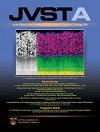实时人工智能增强CeO2纳米结构缺陷工程
IF 2.1
3区 材料科学
Q3 MATERIALS SCIENCE, COATINGS & FILMS
引用次数: 0
摘要
由于其独特的缺陷结构,CeO2纳米结构已被用于各种生物医学,传感器和催化应用,使其具有再生氧化特性。CeO2纳米结构的缺陷工程具有重要的意义,使其能够用于特定的应用。尽管有各种各样的合成方法,但对缺陷结构进行精确和可逆的控制是一项挑战。在此背景下,在当前的工作中,我们探索了机器学习(ML)增强CeO2纳米膜缺陷工程。在我们早期的工作中[J]。真空吸尘器。科学。抛光工艺。[A 39, 060405(2021)],我们已经开发了一种使用原位椭偏振测量的CeO2原子层沉积工艺。在目前的工作中,通过原位光谱椭偏仪和非原位XPS收集的数据使用两种ML算法(梯度增强和随机森林回归)进行关联,以更好地控制化学性质。缺陷结构是CeO2纳米材料的理想性能之一,其特征是Ce3+/Ce4+氧化态比导致其再生性能。我们已经证明了CeO2纳米膜的缺陷结构可以使用两种不同的方法,使用训练好的ML算法实时预测原位椭偏数据。第一种方法是使用ML算法(k近邻)间接预测厚度,然后使用实验校准曲线进行Ce3+/Ce4+估计。第二种方法采用更直接的方法,使用梯度增强和随机森林回归,使用实时椭偏数据(振幅比ψ和相位差Δ)进行Ce3+/Ce4+预测。本文章由计算机程序翻译,如有差异,请以英文原文为准。
Real-time artificial intelligence enhanced defect engineering in CeO2 nanostructures
CeO2 nanostructures have been utilized for various biomedical, sensor, and catalysis applications owing to their unique defect structure, enabling them to have regenerative oxidative properties. Defect engineering in CeO2 nanostructures has major importance, enabling them to be utilized for specific applications. Despite various synthesis methods, it is challenging to have precise and reversible control over defect structures. Against this backdrop, in the current work, we have explored machine learning (ML) enhanced defect engineering of CeO2 nanofilms. In our earlier work [J. Vac. Sci. Technol. A 39, 060405 (2021)], we have developed an atomic layer deposition process for CeO2 using in situ ellipsometry measurements. In the current work, data collected through in situ spectroscopic ellipsometry and ex situ XPS have been correlated using two ML algorithms (gradient boost and random forest regressor) to exert better control over the chemical properties. Defect structures are one of the desired properties in CeO2 nanomaterials, characterized by the Ce3+/Ce4+ oxidation state ratio leading to its regenerative properties. We have shown that the defect structure of the CeO2 nanofilms can be predicted using in situ ellipsometry data in real time using a trained ML algorithm using two different methods. The first method involves an indirect approach of thickness prediction using an ML algorithm (k-nearest neighbors) followed by Ce3+/Ce4+ estimation using an experimental calibration curve. The second method with a more direct approach involves Ce3+/Ce4+ prediction using real-time ellipsometry data (amplitude ratio ψ and phase difference Δ) using gradient boost and random forest regressor.
求助全文
通过发布文献求助,成功后即可免费获取论文全文。
去求助
来源期刊

Journal of Vacuum Science & Technology A
工程技术-材料科学:膜
CiteScore
5.10
自引率
10.30%
发文量
247
审稿时长
2.1 months
期刊介绍:
Journal of Vacuum Science & Technology A publishes reports of original research, letters, and review articles that focus on fundamental scientific understanding of interfaces, surfaces, plasmas and thin films and on using this understanding to advance the state-of-the-art in various technological applications.
 求助内容:
求助内容: 应助结果提醒方式:
应助结果提醒方式:


